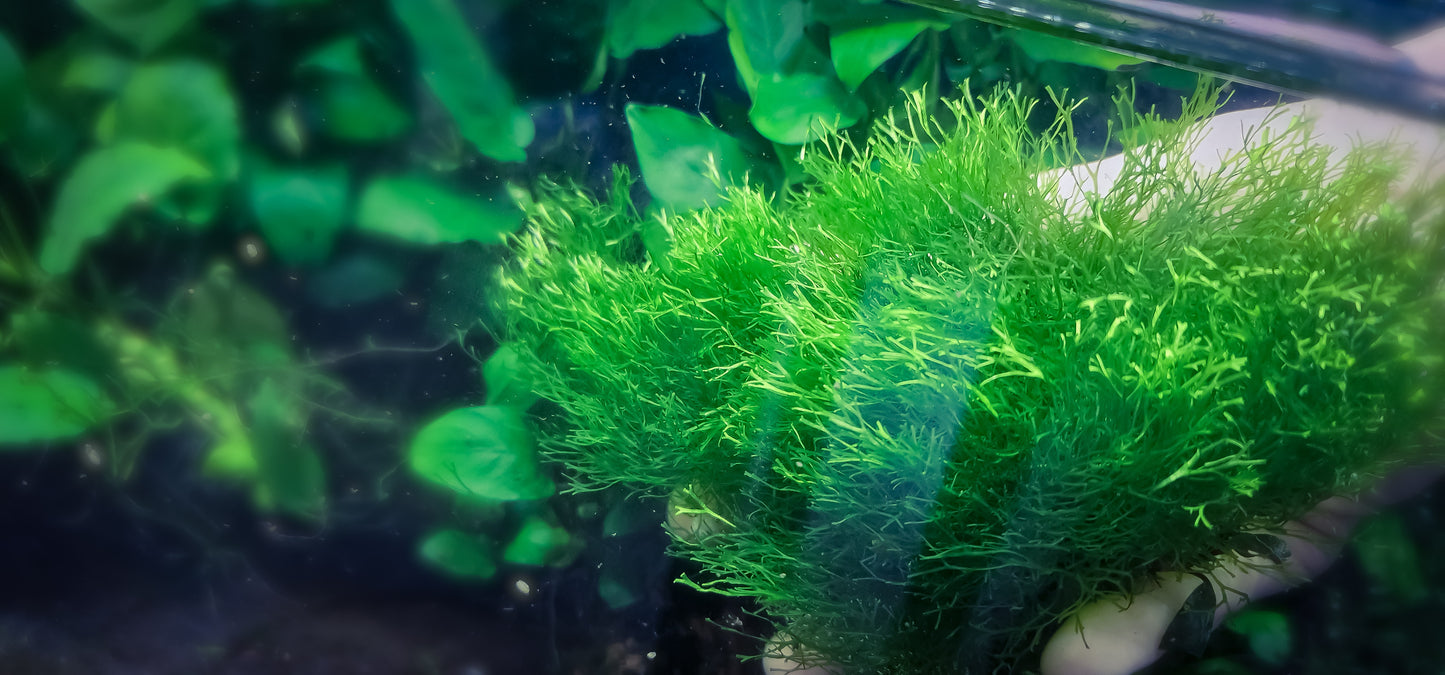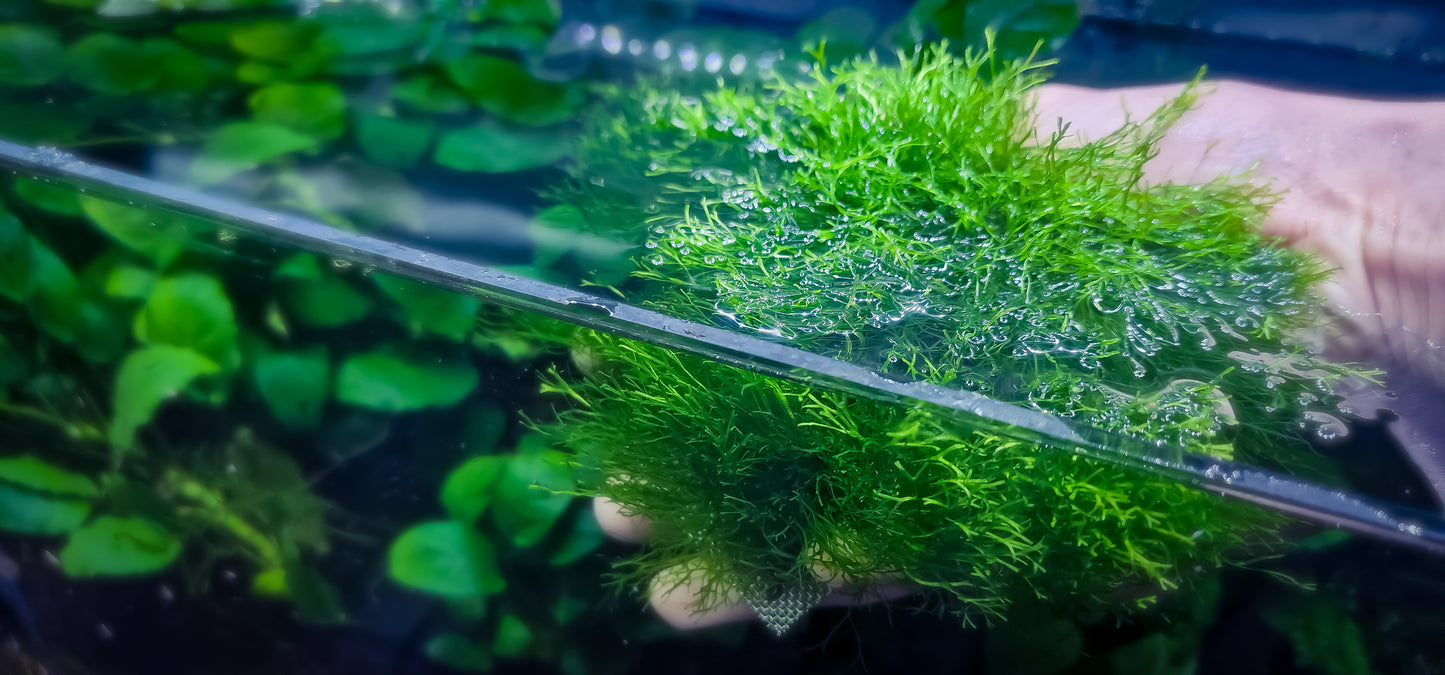Riccardia graffei 7x7cm 2 portion
Riccardia graffei 7x7cm 2 portion
Couldn't load pickup availability
English
Riccardia graeffei, also known as Coral Moss, is a rare liverwort appreciated for its long, fine, and delicate branches that create a coral-like, open texture. Compared to Riccardia chamedryfolia, this variety features more elongated, soft ramification with a more stratified, airy appearance—ideal for refined aquascapes and shrimp tanks. Fully submerged and grown to maturity, it forms dense green cushions without melting.
Cultivation
– Light: Medium to strong for compact growth
– CO₂: Beneficial, especially in high-tech tanks
– Parameters: pH 5.5–6, GH 6–7, KH 2, conductivity 150–200 µS
– Temperature: Prefers below 26 °C for vibrant color and shape
– Fertilization: Requires a balanced micronutrient supply
– Growth rate: Slow to moderate
Leaf morphology
– Type: Liverwort with thin, elongated, slightly translucent branches
– Color: Bright to dark green depending on light intensity
– Structure: Loosely branched and layered, forming rounded cushions
– Attachment: Rhizoids allow it to anchor to rocks and wood
Curiosity
Its softer, more elongated fronds offer excellent refuge for shrimp and fry. When grown under good light and CO₂, it develops a unique coral-like appearance, rarely achieved with other mosses.
---
Italiano
Riccardia graeffei, nota anche come Muschio Corallo, è una epatica rara con ramificazioni lunghe e sottili, dall’aspetto arioso e stratificato. Rispetto alla Riccardia chamedryfolia, presenta rami più fini e morbidi, ideali per creare texture naturali e rifugi per gamberetti. Viene fornita in forma completamente sommersa, adulta, già stabilizzata e pronta alla crescita.
Coltivazione
– Luce: Media o forte per una crescita compatta
– CO₂: Utile, soprattutto in acquari high-tech
– Valori: pH 5.5–6, GH 6–7, KH 2, conducibilità 150–200 µS
– Temperatura: Preferibile sotto i 26 °C per mantenere forma e colore
– Fertilizzazione: Richiede micronutrienti bilanciati
– Crescita: Da lenta a moderata
Morfologia fogliare
– Tipo: Epatica con fronde allungate e leggermente traslucide
– Colore: Verde brillante o scuro a seconda dell’intensità luminosa
– Struttura: Ramificata e stratificata, forma cuscini tondi
– Ancoraggio: Si fissa su legni e rocce tramite rizoidi
Curiosità
Le sue fronde più lunghe e delicate offrono rifugi ideali per gamberetti e avannotti. In buone condizioni di luce e CO₂, assume un aspetto corallino spettacolare, difficilmente ottenibile con altri muschi.
---
Français
Riccardia graeffei, également appelée Mousse Corail, est une hépatiques rare caractérisée par des ramifications longues et fines, créant un aspect aéré et stratifié. Par rapport à Riccardia chamedryfolia, elle présente des rameaux plus souples et étendus, parfaits pour les bacs à crevettes et les aquascapes délicats. Elle est livrée déjà adulte, en forme immergée.
Culture
– Lumière : Moyenne à forte pour une forme compacte
– CO₂ : Bénéfique dans les bacs plantés techniques
– Paramètres : pH 5.5–6, GH 6–7, KH 2, conductivité 150–200 µS
– Température : Préfère moins de 26 °C
– Fertilisation : Micronutriments équilibrés nécessaires
– Croissance : Lente à modérée
Morphologie des feuilles
– Type : Hépatiques à frondes longues et translucides
– Couleur : Vert vif à foncé selon la lumière
– Structure : Ramifiée, en coussins arrondis
– Fixation : Rhizoïdes s’attachant à bois ou pierres
Anecdote
Les frondes fines offrent une protection idéale pour les crevettes et alevins. Cultivée dans de bonnes conditions, elle prend l’aspect d’un mini récif corallien spectaculaire.
---
Deutsch
Riccardia graeffei, auch bekannt als Korallenmoos, ist ein seltenes Lebermoos mit langen, feinen Trieben und einer luftigen, geschichteten Struktur. Im Vergleich zu Riccardia chamedryfolia besitzt sie weichere, längere Äste, die sich ideal für filigrane Aquascapes und Garnelenbecken eignen. Bereits in submerser Form kultiviert, ist sie sofort einsatzbereit.
Pflege
– Licht: Mittel bis stark für kompaktes Wachstum
– CO₂: Vorteilhaft, besonders im High-Tech-Aquarium
– Wasserwerte: pH 5.5–6, GH 6–7, KH 2, Leitwert 150–200 µS
– Temperatur: Ideal unter 26 °C
– Düngung: Ausgewogene Mikronährstoffversorgung erforderlich
– Wachstum: Langsam bis moderat
Blattmorphologie
– Typ: Lebermoos mit langen, halbtransparenten Trieben
– Farbe: Hell- bis dunkelgrün je nach Licht
– Struktur: Locker verzweigt, kissenartig wachsend
– Befestigung: Mit Rhizoiden an Holz oder Stein
Besonderheit
Die feinen Triebe bieten ideale Verstecke für Garnelen. Unter optimalen Bedingungen zeigt die Pflanze ein einzigartiges Korallenriff-ähnliches Aussehen.




